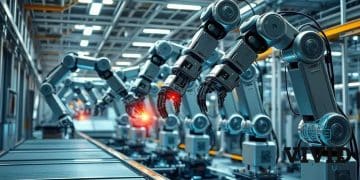AI-driven productivity gains in your business


The rise of AI-driven solutions is changing the way businesses operate, offering significant productivity gains by automating tasks, optimizing processes, and improving decision-making.
Have you ever wondered how implementing AI could streamline your workflows and enhance efficiency?
Let’s dive into how AI is transforming businesses and driving greater results.
Understanding AI-driven productivity
AI-driven productivity is revolutionizing the way businesses operate and individuals perform tasks in the workplace.
With the increasing reliance on artificial intelligence (AI) tools, many companies are adopting smart technologies to improve their operational efficiency.
By automating routine tasks and enhancing decision-making processes, AI not only helps streamline work but also opens new avenues for innovation.
At its core, AI-driven productivity involves utilizing AI technologies to handle repetitive chores, analyze vast amounts of data, and provide valuable insights.
By implementing these tools, businesses can shift focus from mundane activities to more creative, strategic tasks. As a result, productivity increases, and companies can unlock higher potential for growth and innovation.
How AI-Driven Productivity Enhances Efficiency
AI enhances productivity by automating various aspects of work that would otherwise take up a significant amount of time.
Automation is one of the primary benefits of AI-driven productivity, enabling businesses to eliminate time-consuming tasks and streamline operations.
Whether it’s processing data, managing schedules, or optimizing workflows, AI accelerates these processes and provides more accurate results.
Some of the key benefits of AI-driven productivity include:
- Time Efficiency: Automation significantly reduces the time spent on repetitive tasks. By handling simple, time-consuming activities, AI allows employees to focus on tasks that require human creativity and problem-solving.
- Data-Driven Insights: AI tools can analyze large datasets at a speed and precision that humans might miss. With this data analysis, businesses can make informed decisions faster, leading to better strategies and outcomes.
- Smart Scheduling: AI-driven smart assistants can manage your calendar, organize meetings, and remind you of deadlines, ensuring you stay on track with important tasks and objectives.
- Personalized User Experiences: AI systems can analyze customer behavior and personalize interactions, leading to better customer satisfaction and engagement.
These benefits highlight how AI tools can transform day-to-day tasks.
By reducing human error, increasing accuracy, and speeding up processes, AI-driven productivity allows businesses to operate more efficiently, giving them a competitive edge in today’s fast-paced environment.
Implementing AI in Your Work Environment
While integrating AI-driven productivity tools might seem intimidating, it’s crucial to start small and gradually expand.
For example, implementing simple AI solutions, such as chatbots for customer service or data analysis tools, can immediately improve workflows without disrupting daily operations.
Many companies that have successfully implemented AI-driven productivity tools report significant improvements in efficiency and employee satisfaction.
AI tools often adapt over time, learning from users’ preferences and behaviors, making them even more effective.
As these tools become better suited to specific business needs, they continue to boost productivity in ways that were previously impossible with traditional methods.
By investing in AI-driven solutions, businesses can create more streamlined operations, enhance customer experiences, and optimize employee efforts.
As the use of AI becomes more widespread, companies that embrace these technologies will benefit from increased growth, innovation, and competitive advantage.
Steps to Successfully Implement AI-Driven Solutions
To make the most out of AI-driven productivity, businesses should follow a structured approach to implementation. Identifying key areas where AI can provide the most value is the first step.
These areas might include automating administrative tasks, improving customer service, or enhancing decision-making processes through data analysis.
Once businesses have identified where AI can be most effective, they should:
- Start small with manageable tools and gradually scale up.
- Provide training for employees to ensure they understand how to use AI solutions effectively.
- Continuously evaluate the impact of AI on productivity and make adjustments as needed.
With the right approach, integrating AI-driven productivity solutions will significantly enhance business operations and contribute to long-term success.
Real-world examples of AI enhancing productivity
The impact of AI-driven productivity is becoming increasingly visible across industries as companies adopt artificial intelligence to enhance efficiency and streamline operations.
From automating mundane tasks to offering deep insights into customer preferences, AI-driven technologies are helping businesses optimize performance, reduce costs, and drive innovation.
These advancements are not limited to any specific industry; they are reshaping sectors ranging from manufacturing to healthcare, ensuring that companies stay competitive in a rapidly evolving marketplace.
For instance, in industries like retail and manufacturing, AI-driven systems are enabling companies to perform complex tasks with speed and accuracy, freeing up resources for more value-driven activities.
As companies continue to rely on AI to improve their workflow, the result is a significant gain in productivity, which translates to both improved outcomes and customer satisfaction.
Case Studies of AI-Driven Impact
Several companies across various industries have successfully implemented AI-driven solutions, driving significant improvements in productivity. Here are some notable examples:
Amazon has integrated AI-driven algorithms to optimize its inventory management system. These AI systems predict stock levels, reduce errors, and improve delivery timelines.
By automating inventory processes, Amazon enhances operational efficiency and improves the overall customer experience.
Netflix has taken advantage of AI-driven recommendation systems that analyze user data and suggest personalized content to enhance user engagement.
This has boosted customer retention and increased user satisfaction, demonstrating the importance of AI in creating a tailored user experience.
Salesforce utilizes AI-driven tools to analyze customer data, which helps businesses create personalized marketing campaigns and refine sales strategies.
By integrating AI, companies can target customers more effectively, boosting conversion rates and improving marketing ROI.
In healthcare, IBM Watson uses AI-driven technology to analyze vast amounts of patient data, assisting doctors in diagnosing diseases faster and more accurately.
This AI-driven system significantly reduces human error and accelerates decision-making in critical medical situations.
These case studies reveal that AI-driven productivity solutions go beyond theoretical benefits, they offer real-world, tangible improvements in efficiency, decision-making, and overall business performance.
Benefits of Implementing AI-Driven Productivity Solutions
Implementing AI-driven solutions brings a wealth of advantages for companies looking to enhance productivity.
These technologies automate tasks that would otherwise require manual input, allowing employees to focus on more strategic, high-value activities.
By using AI to handle repetitive or mundane tasks, businesses can significantly improve efficiency and reduce errors.
Additionally, AI-driven tools process large volumes of data swiftly, enabling organizations to make faster and more informed decisions.
This can lead to better strategic planning, optimized resource allocation, and ultimately, enhanced profitability.
Another benefit of AI-driven productivity is its potential to improve workplace satisfaction. With the automation of routine tasks, employees can shift their focus toward more complex and creative endeavors, leading to higher job satisfaction and engagement.
Moreover, AI-driven tools provide a level of precision and accuracy that human labor alone cannot match. This results in fewer mistakes, higher quality products or services, and a more streamlined operation overall.
Incorporating AI-driven technologies into a business allows organizations to operate more efficiently, reduce costs, and improve overall performance, paving the way for growth and success.
Future Potential of AI-Driven Productivity
Looking ahead, the future of AI-driven productivity is promising. As AI technologies continue to evolve, new opportunities for automation, efficiency, and data analysis will emerge, reshaping industries and driving business growth.
The continuous improvements in machine learning and natural language processing are set to revolutionize the way businesses approach productivity.
By investing in AI-driven solutions now, businesses can position themselves to capitalize on future technological advancements.
Whether it’s automating more complex tasks, improving customer interactions, or making smarter business decisions, the future of AI-driven productivity holds significant promise.
As organizations become increasingly reliant on AI for their day-to-day operations, those that invest in and adapt to AI-driven solutions early will likely maintain a competitive edge and lead in their respective industries.
Steps to integrate AI into your workflow

Integrating AI-driven tools into your workflow is more than just a technological upgrade, it’s a strategic move to boost productivity.
By leveraging artificial intelligence, businesses can optimize operations, streamline processes, and make smarter decisions.
The process of integrating AI can seem complex, but following a few fundamental steps will make the transition smoother and more effective.
Before diving into the implementation, it’s crucial to assess where AI-driven solutions can have the most significant impact.
Identifying the right processes to automate or optimize will ensure that AI tools provide real value, enhancing both efficiency and the bottom line.
Key Steps for AI Integration in Your Business Workflow
Successfully integrating AI-driven tools into your workflow involves several key steps that will allow you to achieve significant productivity gains. Here’s a breakdown of the process:
1. Research AI Tools:
The first step is to research various AI-driven tools that align with your business needs. For example, if customer service is a priority, implementing AI chatbots can improve response time and customer satisfaction.
If data analysis is a key focus, exploring AI-powered analytics platforms can help you gain actionable insights from large datasets.
It’s essential to evaluate various options and choose tools that best fit your objectives, such as marketing automation tools, customer relationship management (CRM) systems, and data-processing solutions.
2. Set Clear Goals:
Defining your goals is crucial to the successful implementation of AI-driven solutions. What do you hope to achieve by integrating AI?
Whether it’s improving customer service, reducing operational costs, or enhancing productivity, setting clear goals allows you to measure the success of your AI implementation.
Additionally, understanding the expected outcomes will help you track performance and make adjustments where necessary.
3. Start Small and Scale Gradually:
Don’t rush into integrating complex systems all at once. Start small with one application or department that can benefit from AI-driven tools, such as social media management or automated customer inquiries.
Gradually expand the AI integration as you monitor performance and uncover areas for improvement.
For instance, you might start with an AI scheduling assistant, then move on to more advanced solutions like predictive analytics tools or workflow automation systems as you gain confidence.
4. Train Your Team:
For AI integration to be effective, it’s crucial that your team understands how to use the new tools. Training employees on how to interact with AI-driven solutions will ensure they use the tools efficiently, maximizing the benefits.
Provide ongoing training sessions, resources, and support to help your team adapt to the new technology. This step is vital to prevent resistance and ensure that employees can fully leverage the capabilities of AI.
5. Monitor and Adjust:
Once the AI-driven tools are integrated, it’s essential to monitor how they impact productivity. This continuous feedback loop will help you evaluate the effectiveness of AI in your workflow.
Keep track of key metrics like time saved, customer satisfaction, and improvements in decision-making. If necessary, make adjustments to the integration strategy based on the insights you gather.
Employee Engagement and Adoption
Employee buy-in is crucial when integrating AI-driven solutions into your business workflow. Engaging your team throughout the process, from the initial planning stages to post-integration, will increase the likelihood of a smooth transition.
Foster an open dialogue, offer incentives for embracing new technologies, and highlight the benefits AI can bring to their daily tasks.
This approach not only encourages adoption but also helps address any concerns employees may have about the changes.
Scalability and Future-Proofing
Another aspect to consider during the integration process is scalability. Start with tools that provide immediate value, but always keep in mind the future potential.
As your business grows and evolves, AI solutions can be expanded to other areas of your workflow, providing even greater efficiency and productivity.
By implementing scalable AI-driven systems, you can future-proof your business against industry shifts and technological advancements.
AI-driven solutions can transform how your business operates, leading to enhanced productivity and efficiency. However, careful planning, training, and monitoring are crucial to maximizing their effectiveness.
With the right approach, you can seamlessly integrate AI-driven tools into your business and position your company for sustained success
Assessing the impact of AI on productivity
Assessing the impact of AI-driven productivity tools is crucial for any business looking to enhance its operations and long-term performance.
Understanding how these technologies affect efficiency and workflow will allow businesses to adjust their strategies and ensure they are maximizing the benefits.
By evaluating the effects of AI, organizations can make informed decisions that align with their overall goals.
Measuring the success of AI integration requires businesses to track specific metrics that reflect changes in productivity.
By monitoring these indicators, businesses can identify which areas have shown the most improvement and where adjustments are needed.
Key Metrics for Assessing AI-Driven Productivity
There are several key performance indicators (KPIs) that businesses should monitor to gauge the impact of AI-driven solutions on their productivity.
These metrics can reveal how well AI tools are working and whether they are achieving the desired results.
Time Savings:
One of the most immediate and tangible benefits of AI-driven tools is the time saved by automating repetitive tasks.
Businesses can evaluate how much time employees have gained by delegating mundane tasks to AI systems, allowing them to focus on higher-value activities. Monitoring time savings is a clear way to measure AI’s impact on workflow efficiency.
Cost Reduction:
Another critical metric is the reduction in operational costs. By automating processes and optimizing resource usage, AI can help businesses lower expenses.
Analyzing these savings helps businesses understand the financial benefits of implementing AI tools and whether they lead to greater profitability.
Output Quality:
The quality of work and the accuracy of results is another key area to assess. For example, AI systems can help reduce human error, improve decision-making, and enhance the overall quality of products or services.
Businesses should evaluate error rates, customer feedback, and product quality before and after AI implementation to measure improvements.
Employee Satisfaction:
AI can significantly impact employee morale and engagement. By reducing the time spent on routine tasks, employees are often freed up to focus on more creative and rewarding activities.
Gathering feedback on how employees feel about the changes AI has brought to their work environment can offer valuable insights into the success of AI integration.
Higher levels of satisfaction are likely to lead to greater retention and performance.
In addition to these quantifiable metrics, businesses should also gather qualitative feedback from employees.
Understanding their experiences with AI tools can uncover areas for improvement and provide a more comprehensive assessment of the technology’s impact.
Evaluating Long-Term Effects of AI-Driven Productivity
It’s essential for businesses to conduct periodic reviews of AI-driven systems to ensure they remain effective over time.
While immediate improvements in efficiency and productivity are often apparent, businesses must also consider the long-term effects of these technologies.
As AI tools evolve and new versions are released, businesses should reassess their strategies and identify new opportunities for integration.
Ongoing evaluation helps companies stay ahead of industry changes and ensures that their AI-driven systems continue to align with their goals.
This iterative process of assessment and refinement helps businesses adapt quickly and maintain a competitive edge.
Adapting Strategies Based on AI Insights
The insights gained from assessing the impact of AI-driven tools are invaluable for refining business strategies.
Companies can use this data to adjust their workflow, fine-tune AI tools, and better align their operations with evolving market demands.
Understanding the challenges that arise during AI integration enables businesses to address obstacles and find new solutions for improvement.
Ultimately, regularly assessing AI’s role in productivity helps companies make more informed decisions and adapt their strategies to maximize long-term success.
By continually learning from AI’s impact on their operations, businesses can ensure they stay competitive in a rapidly changing environment.
Future trends in AI-driven productivity

Future trends in AI-driven productivity are poised to significantly alter the way businesses operate, leading to more streamlined and efficient processes.
As artificial intelligence continues to evolve, its impact on the workplace will be transformative, driving both innovation and efficiency.
The future of work will be shaped by increasingly sophisticated AI tools, enabling businesses to remain competitive in a fast-paced, data-driven world.
One of the most significant trends is the rise of machine learning, a type of AI that enables systems to continuously improve based on data.
Machine learning will enhance decision-making by providing more accurate insights and recommendations, ensuring that businesses can make better, data-driven choices.
Emerging Technologies Shaping AI-Driven Productivity
The future of AI-driven productivity will also be influenced by several cutting-edge technologies that are set to revolutionize industries. As AI tools become more advanced, they will enhance efficiency and effectiveness in new and exciting ways.
Natural Language Processing (NLP):
NLP is one of the most promising advancements in AI. This technology allows machines to understand, interpret, and respond to human language with a high degree of accuracy.
As NLP technology matures, businesses will be able to interact with AI tools more naturally, making tasks like customer service, content creation, and data analysis more seamless.
Robotic Process Automation (RPA):
RPA is rapidly transforming business operations by automating repetitive and time-consuming tasks.
With RPA, businesses can streamline processes across industries such as finance, healthcare, and manufacturing, allowing employees to focus on higher-value, strategic tasks. This will lead to enhanced productivity and reduced operational costs.
Predictive Analytics:
Predictive analytics will play a crucial role in helping businesses forecast trends, customer behavior, and market changes.
By leveraging AI-powered algorithms, companies can make more informed decisions, optimize their supply chains, and increase profitability.
This technology will empower businesses to stay ahead of the curve and respond proactively to changing market conditions.
Advanced Collaboration Tools:
AI will also enhance collaboration tools, making remote teamwork more efficient. With AI-driven collaboration tools, businesses will be able to improve communication, task management, and real-time problem-solving.
These tools will make remote work more seamless, fostering better collaboration between teams across different locations and time zones.
Preparing for the AI-Driven Future of Work
As these technologies continue to develop, businesses must adapt to stay competitive. The growing reliance on AI-driven tools means that employees will need to acquire new skills to manage and leverage these technologies effectively.
Companies will need to invest in training programs to ensure their workforce is prepared for the changes AI will bring.
Moreover, as AI becomes more integrated into daily business operations, ethical considerations will play an increasingly important role.
Ensuring fairness, transparency, and accountability in AI applications will be essential to building trust among customers, employees, and regulators.
The Role of Businesses in AI Adoption
Businesses that embrace AI-driven productivity will have a significant advantage in the marketplace.
By staying informed about emerging technologies and investing in AI tools, companies can optimize their operations, reduce costs, and improve customer satisfaction.
However, successful AI adoption requires more than just the latest technology; it involves a strategic approach to integration, training, and ongoing evaluation.
Conclusion: The Future of AI-Driven Productivity and Its Impact
In conclusion, the AI-driven transformation of productivity is a game-changer for businesses looking to optimize operations and improve efficiency.
As AI tools continue to evolve, their ability to automate repetitive tasks, analyze large datasets, and provide insightful decision-making will only grow more valuable.
Embracing these technologies not only enhances workflow but also opens up new avenues for innovation and job satisfaction.
The rise of AI-driven systems is reshaping industries globally, and companies must adapt to harness these advancements.
As businesses invest in training their workforce and integrating AI tools into their processes, the potential for growth and improvement is limitless.
Looking ahead, machine learning, natural language processing, and predictive analytics will continue to drive efficiency and foster better decision-making.
By understanding and embracing AI-driven productivity, businesses can navigate the complexities of the modern landscape and secure a competitive edge.
Whether through AI-driven automation or smarter decision-making processes, the future of work will be shaped by these powerful technologies.
For more insights on how AI-driven systems are transforming productivity, check out this detailed overview and explore further. Embracing AI-driven solutions is the way forward for any business aiming to thrive in the evolving digital economy.
FAQ – Frequently Asked Questions about AI-driven Productivity
How can AI tools enhance workplace productivity?
AI tools help streamline processes and automate repetitive tasks, allowing employees to focus on more strategic and creative work.
What metrics should I use to assess AI’s impact on my business?
Key metrics include time savings, cost reductions, output quality, and employee satisfaction to evaluate the effectiveness of AI solutions.
Why is employee training important when implementing AI?
Training ensures that staff can effectively use AI tools, maximizing their benefits and improving overall performance.
What future trends should companies be aware of in AI?
Emerging trends include advancements in machine learning, natural language processing, and ethical AI practices that will shape the future of productivity.
Liked the article?





